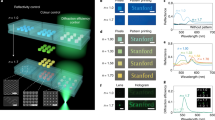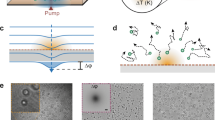Abstract
Recently, there has been intense interest in photonic devices based on microfluidics, including displays1,2 and refractive tunable microlenses and optical beamsteerers3,4,5 that work using the principle of electrowetting6,7. Here, we report a novel approach to optical devices in which static wrinkles are produced at the surface of a thin film of oil as a result of dielectrophoretic forces8,9,10. We have demonstrated this voltage-programmable surface wrinkling effect in periodic devices with pitch lengths of between 20 and 240 µm and with response times of less than 40 µs. By a careful choice of oils, it is possible to optimize either for high-amplitude sinusoidal wrinkles at micrometre-scale pitches or more complex non-sinusoidal profiles with higher Fourier components at longer pitches. This opens up the possibility of developing rapidly responsive voltage-programmable, polarization-insensitive transmission and reflection diffraction devices and arbitrary surface profile optical devices.
This is a preview of subscription content, access via your institution
Access options
Subscribe to this journal
Receive 12 print issues and online access
$209.00 per year
only $17.42 per issue
Buy this article
- Purchase on Springer Link
- Instant access to full article PDF
Prices may be subject to local taxes which are calculated during checkout





Similar content being viewed by others
References
Hayes, R. A. & Feenstra, B. J. Video-speed electronic paper based on electrowetting. Nature 425, 383–385 (2003).
Heikenfeld, J. & Steckl, A. J. High-transmission electrowetting light valves. Appl. Phys. Lett. 86, 151121 (2005).
Berge, B. & Peseux, J. Variable focal lens controlled by an external voltage: An application of electrowetting. Euro. Phys. J. E 3, 159–163 (2000).
Kuiper, S. & Hendriks, B. H. W. Variable-focus liquid lens for miniature cameras. Appl. Phys. Lett. 85, 1128–1130 (2004).
Smith, N. R., Abeysinghe, D. C., Haus, J. W. & Heikenfeld, J. Agile wide-angle beam steering with electrowetting microprisms. Opt. Express 14, 6557–6563 (2006).
de Gennes, P. G. Wetting: statics and dynamics. Rev. Mod. Phys. 57, 827–862 (1985).
Mugele, F. & Baret, J. C. Electrowetting: from basics to applications. J. Phys. Condens. Matter 17, R705–R774 (2005).
Pellat, H. Mésure de la force agissant sur les diélectriques liquides non électrisés placés dans un champ électrique. C. R. Acad. Sci. Paris 119, 691–694 (1895).
Pohl, H. A. Dielectrophoresis: The Behaviour of Neutral Matter in Non-Uniform Electric Fields, Cambridge Monographs on Physics (Cambridge Univ. Press, 1978).
Lorrain, P. & Corson, D. R. Electromagnetic Fields and Waves 2nd edn (W. H. Freeman, 1970).
Pethig, R. Using inhomogeneous a.c. electrical fields to separate and manipulate cells. Crit. Rev. Biotech. 16, 331–348 (1996).
Jones, T. B., Gunjii, M., Washizu, M. & Feldman, M. J. Dielectrophoretic liquid actuation and nanodroplet formation. J. Appl. Phys. 89, 1441–1448 (2001).
Born, M. & Wolf, E. Principles of Optics 7th edn (Cambridge Univ. Press, 2005).
Knovel Critical Tables 2nd edn (Knovel, 2003).
Hutley, M. C. Diffraction Gratings (Academic Press, 1982).
Goodman, J. W. Introduction to Fourier Optics 2nd edn (McGraw-Hill, 1996).
Hubert, H. & Girault, H. H. Electrowetting: shake, rattle and roll. Nature Mater. 5, 851–852 (2006).
Bucaro, M. A., Kolodner, P. R., Taylor, J. A., Sidorenko, A., Aizenberg, J. & Krupenkin, T. N. Tunable liquid optics: electrowetting-controlled liquid mirrors based on self-assembled janus tiles. Langmuir 25, 3876–3879 (2009).
Herminghaus, S. Dynamical instability of thin liquid films between conducting media. Phys. Rev. Lett. 83, 2359–2361 (1999).
Schäffer, E., Thurn-Albrecht, T., Russell, T. P. & Steiner, U. Electrically induced structure formation and pattern transfer. Nature 403, 874–877 (2000).
Staicu, A. & Mugele, F. Electrowetting-induced oil film entrapment and instability. Phys. Rev. Lett. 97, 167801 (2006).
Komanduri, R. K., Chulwoo, O. & Escuti, M. J. Reflective liquid crystal polarization gratings with high efficiency and small pitch, in Liquid Crystals XII (ed. Khoo, Iam Choon) Proc. SPIE, 7050, 70500J (2008).
De La Tocnaye, J. L. D. Engineering liquid crystals for optimal uses in optical communication systems. Liq. Cryst. 31, 241–269 (2004).
Eldada, L. Optical communication components. Rev. Sci. Instrum. 75, 575–593 (2004).
Mias, S. & Camon, H. A review of active optical devices: I. Amplitude modulation. J. Micromech. Microeng. 18, 083001 (2008).
Bowden, N., Brittain, S., Evans, A. G., Hutchinson, J. W. & Whitesides, G. M. Spontaneous formation of ordered structures in thin films of metals supported on an elastomeric polymer. Nature 393, 146–149 (1998).
Acknowledgements
The authors gratefully acknowledge J. Fyson at Kodak (European Research) Ltd and N. J. Shirtcliffe and C. L. Trabi at Nottingham Trent University for fruitful discussions. G.W. gratefully acknowledges The EPSRC/DTI COMIT Faraday Partnership and Kodak (European Research) Ltd for funding.
Author information
Authors and Affiliations
Contributions
C.V.B., M.I.N. and G.M. conceived the concept and planning. C.V.B., G.G.W. and M.I.N. designed the experiment. C.V.B. and G.M. carried out theoretical work. C.V.B. wrote the paper and G.G.W. performed the experimental work and data analysis.
Corresponding author
Supplementary information
Supplementary information
Supplementary information (PDF 579 kb)
Supplementary information
Supplementary information Movie 1 (AVI 49 kb)
Supplementary information
Supplementary information Movie 2 (AVI 25 kb)
Rights and permissions
About this article
Cite this article
Brown, C., Wells, G., Newton, M. et al. Voltage-programmable liquid optical interface. Nature Photon 3, 403–405 (2009). https://doi.org/10.1038/nphoton.2009.99
Received:
Accepted:
Published:
Issue Date:
DOI: https://doi.org/10.1038/nphoton.2009.99



